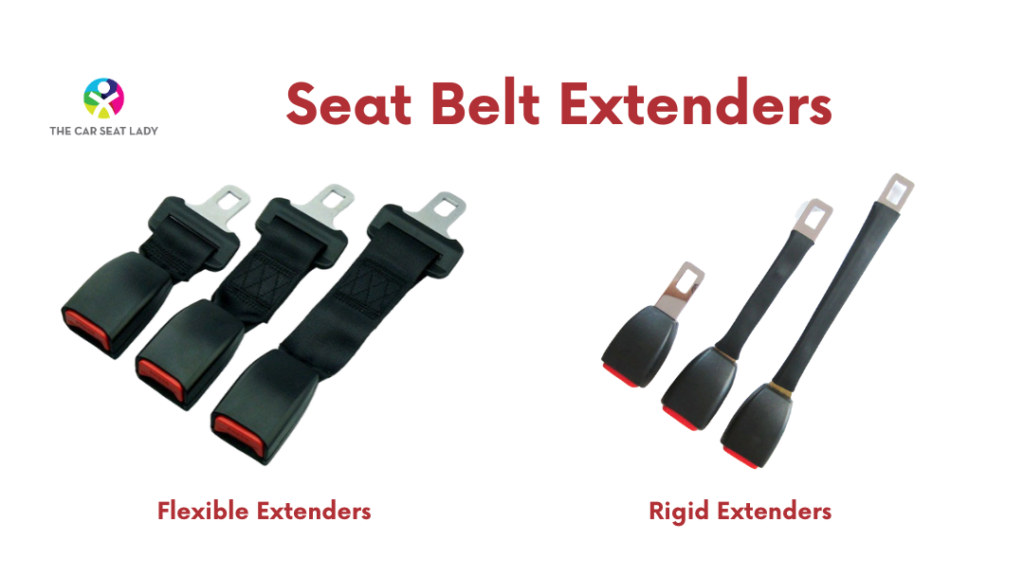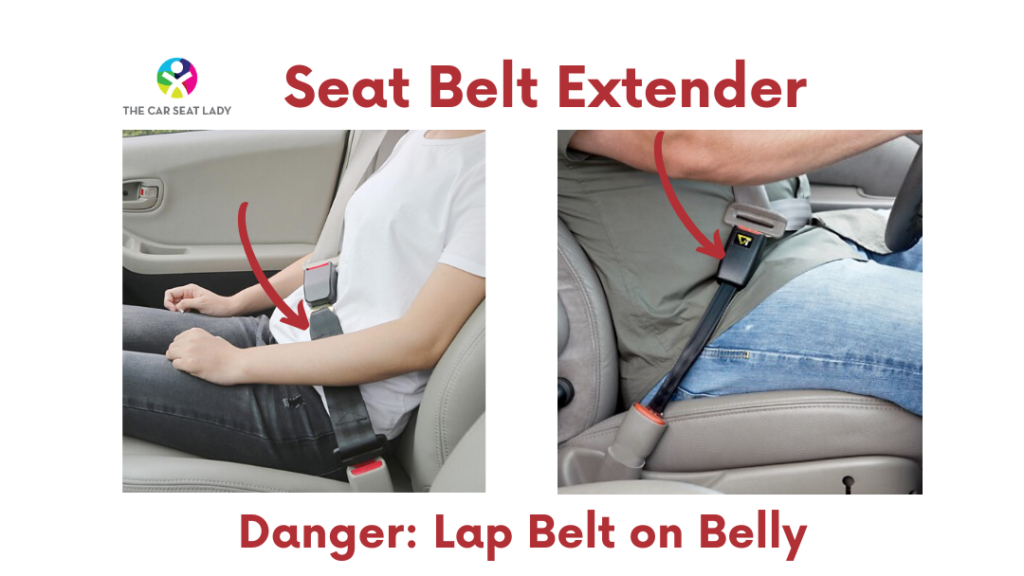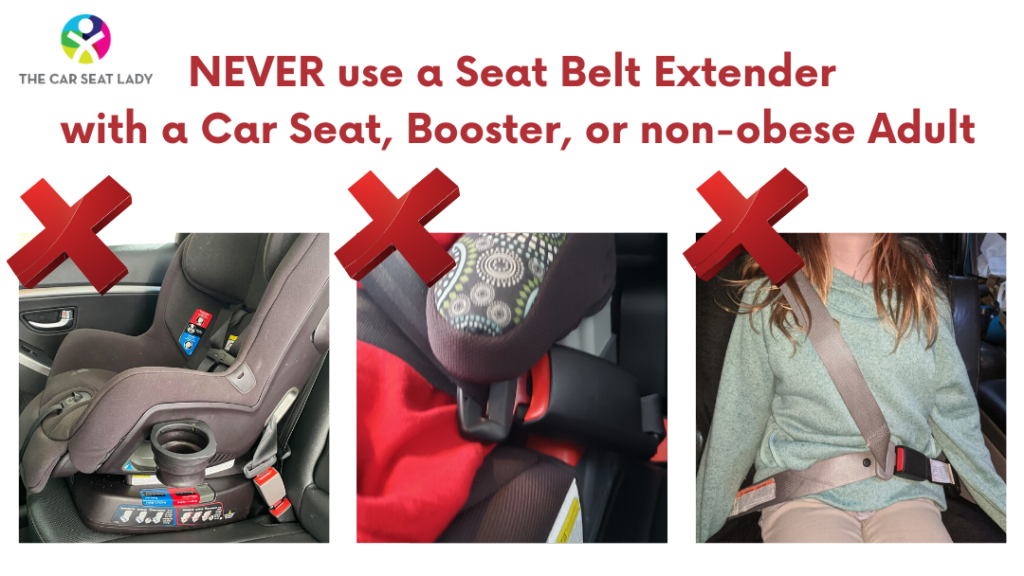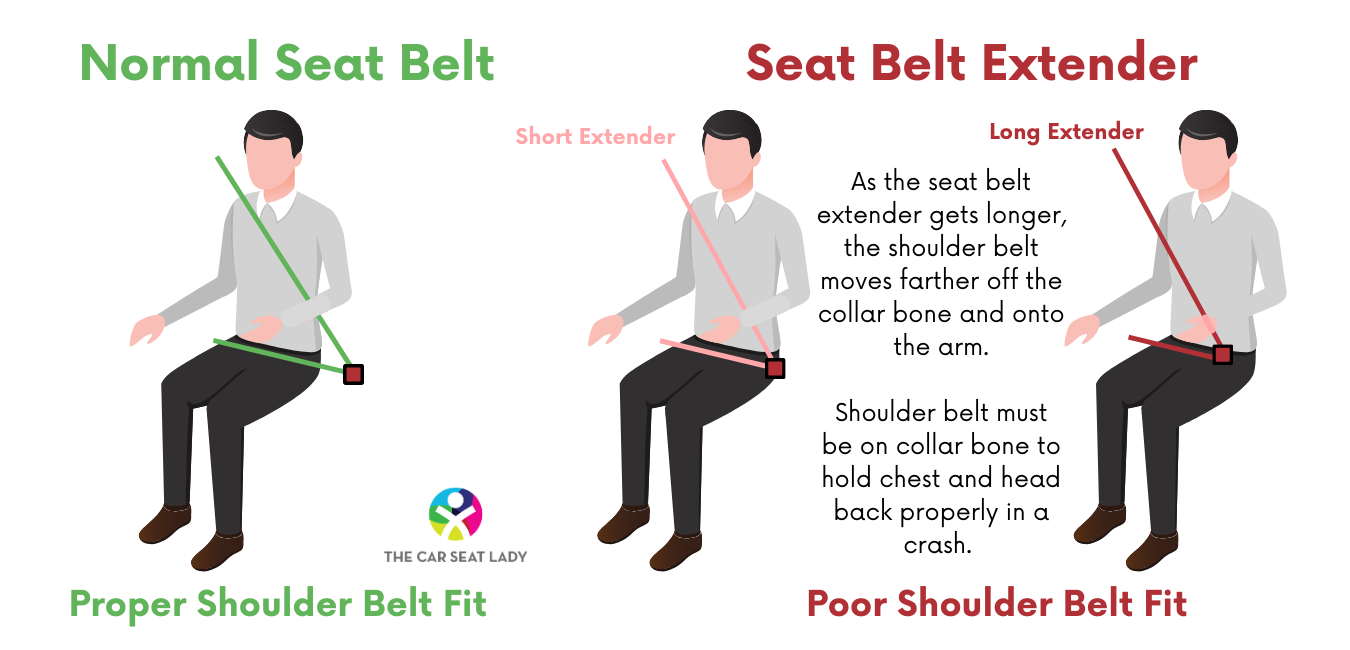A seat belt extender is an extra piece that goes between the male and female ends of the seat belt to make the seat belt longer.

An extender allows an obese adult to buckle up in situations where the belt is otherwise too short to go around their body. This is the extender’s ONLY purpose and the ONLY way an extender should be used.
Unfortunately, extenders are often advertised to “solve” lots of problems. We’ve seen them advertised as a way to make it easier to buckle a child in a booster, and as a way of repositioning the seat belt fit on a pregnant woman. It is NOT SAFE to use a seat belt extender in either of these situations.

The only time it is safe to use a seat belt extender in a car is when both of the following criteria are met:


Some vehicle manufacturers do NOT offer seat belt extenders. It is unclear why – but they may have concerns about the ability of their safety restraints to hold someone of this size in a crash. Seat belts are tested to 6,000 lbs of force – but a person weighing several hundred pounds could exert more force than this on a seat belt during a severe crash.

Extenders are not generic. The extender must match the buckle used in that specific vehicle.
Just because you can get the seat belt to click into the extender does NOT mean the seat belt will stay buckled in a crash when several thousand pounds of force are applied to the buckle. And if the seat belt unbuckles in the crash, then not only are you in grave danger, but so is everyone else in the car since you can fly on top of them.
In a crash everything becomes much heavier due to the G-forces (force of gravity). You’ll effectively weigh your usual weight times however many G’s are in the crash. In a 30mph crash like they use to crash test car seats, there are about 25 G’s. A 250 pound adult in a crash with 25 G’s is going to feel like they weigh 6,250 (250 x 25 = 6,250). Their body will put 6,250 pounds of force on the seat belt and the extender.
If you get a seat belt extender from a specific vehicle manufacturer, let’s say Ford, for example, you can not assume it will work in all Ford vehicles. The Ford Escape may use a different seat belt buckle than the Ford Explorer – and therefore the extender would be different for these two Ford vehicles.

Extenders make the buckle stalk (the female end of the buckle) longer… sometimes a lot longer. As the female end gets longer it moves the buckle from the side of your hip, where it should be, farther and farther towards the middle of your body. As the buckle moves closer to the center of your body, the shoulder belt moves farther out of position, sliding onto your arm instead of resting on your collar bone. This causes a huge safety issue. The shoulder belt has a very important job in a crash. It has to keep your head and chest held tight so that they don’t move too far forward. If they move too far forward, your head may hit hard parts of the car. If the shoulder belt is on your arm (where it should never be) then your head, neck, and torso will not be well protected, because the shoulder belt won’t be able to hold you back. It won’t be in the right place on your body in order to do its job. You’ll jack-knife over yourself, making it likely that you will hit your head on something hard, like the back of the front seat, the door frame, or the window.
With a large adult – one who otherwise couldn’t buckle their seat belt without using an extender – the use of an extender that is as short as possible to just allow them to buckle the seat belt will not change the shoulder belt fit significantly as the seat belt buckle will remain close to the side of the body rather than in front and towards the center of the body.
The smaller the person using a seat belt extender, the less it will take for the shoulder belt to slide off the arm – and the greater the risk to using a belt extender.
Click here to check out our our page on narrowest boosters.
The recently discontinued Maxi Cosi Rodifix booster was the best high back booster to try as not only does it have a narrow footprint but also its lack of arm rests make it easier to see and get your hand in to reach the seat belt buckle. If you can’t find one, look at the Peg Perego Shuttle Plus 120, but make sure the seat belt fits your child well before committing to it (it is not always a good match). You can also consider the Graco Slimfit3 LX, which is a very narrow car seat that has a short-lived booster mode.
For a backless booster, the Graco Rightguide is the best one to try.
Sometimes, no matter how narrow the booster, it is too hard to get a hand in to buckle or unbuckle the seat belt each time. Try having the child climb into a buckled booster as shown in this video.
If the seat belt buckle in your car is flexible, and keeps flopping down which can make it hard for some kids to buckle, try our “pool noodle trick”.
Flexible buckles are connected to the vehicle using a piece of seat belt material. Flexible buckles can move a little – especially side to side – which often lets them get out of the way to allow easier buckling for the person sitting next to a car seat or booster.
Rigid buckles are either connected to the vehicle using a rigid metal stalk – or they are flush with the vehicle’s seat cushion. Either way, rigid buckles can’t move out of the way even if you beg them to!
For flexible buckles, sometimes you need to buckle them and have someone pull the seat belt as tight as they can to move the buckle as far away from the seat next to it… so that when you install a car seat in the neighboring position the car seat doesn’t sit on top of the buckle for another spot in the car.
Here’s an example of pulling the seat belt buckle out of the way so that it doesn’t get stuck underneath a car seat in the neighboring seat.
Try what we show in the video below if your seat belt buckle is mostly rigid (but has a little bit of give) like this one. Any soft material will do – washcloth, folded paper, etc.
It is easier to buckle and unbuckle a child in a 5 point harness than in a booster. When space is tight – or it is hard to access the seat belt buckle because it is flush with the vehicle seat – keeping a child in a 5-point harness may be a good solution.
We recommend trying the Chicco MyFit – it is relatively narrow on the outside but has a higher harness capacity (by virtue of a really high top shoulder strap height) than almost any other seat.
If the child wants to be more independent in their own unbuckling, check out the UnBuckleMe
We are a reader-supported site. We earn an affiliate commission when you buy through our links.
FTC Disclosure: Affiliate links are included in this page. No monetary compensation was provided, however, a few of the reviewed products were supplied by the manufacturer or distributor to help facilitate the review. All opinions are those of The Car Seat Lady, LLC.
